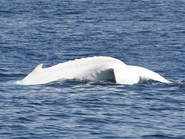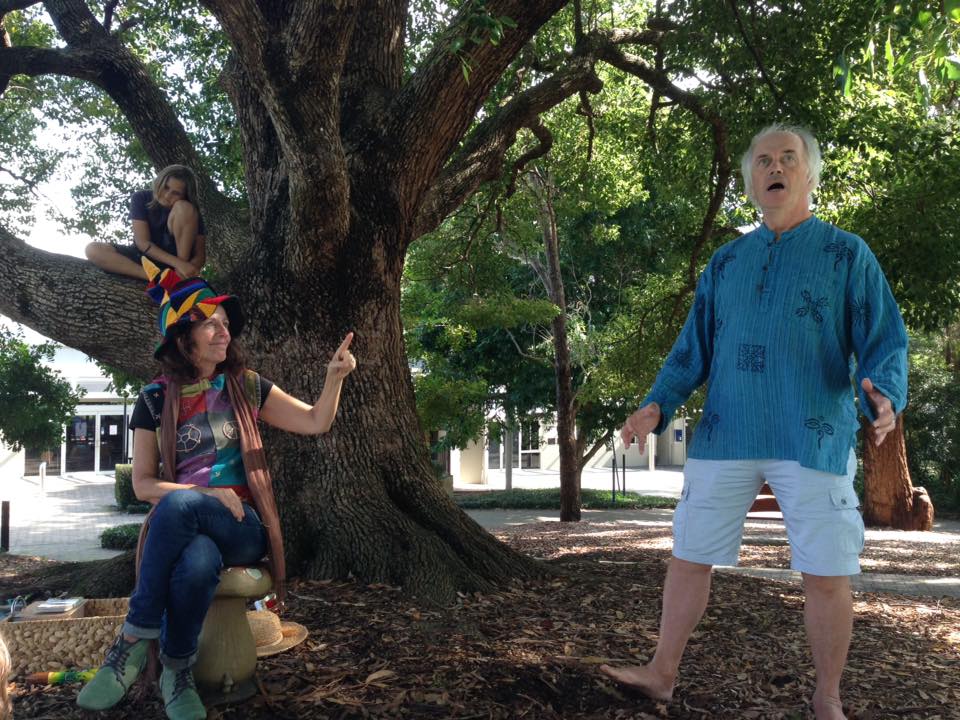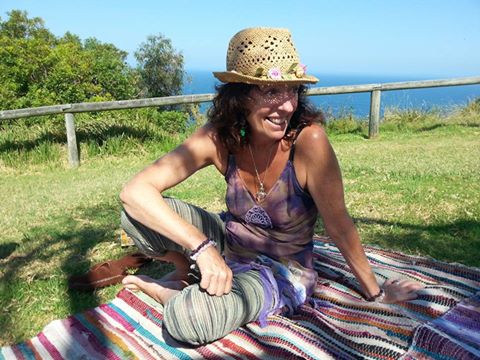|
10/29/2017 0 Comments The Legend of Luna, White Whale This is tale I wrote a few years ago for our local Whale Dreaming Festival. I love to share this tale and at the end of the story, ask the audience to shut their eyes and listen for the wise song of the whale as I play a crystal bowl. Luna is one of our many original environmental tales. We also love to share traditional folk & fairy tales and ancient myths as their environmental wisdom speaks to us across the ages. Photo; Spirit of Goldcoast Whale Watching Tour Mythical White Creatures In cultures all over the world, the birth or appearance of a white animal holds special significance; a prophecy or a blessing. Many myths and legends have been told about these magical creatures. In North America they have The Story of the White Buffalo, in India the Myth of the White Tiger and in Australia we have The Legend of Luna, The White Whale. Though an old legend, this story is not ancient, for in ancient times the people of Australia lived in harmony with the land and the ocean. This story took place when I was just a girl. One cool salty night, in warm tranquil waters, when the moon was full and high in the sky, a huge humpback whale labored long then gave birth to a female calf. Instinctively, the mammoth mother pushed her calf to the surface of the sea, and there, bathed only in soft moonlight the young calf drew her first breath. The Moon and mother whale were amazed to see that the calf shone as white as the moon herself and they named the white whale, Luna-Moon Sister. Wise Song of the Whales Luna grew quickly as she swam with her mother along the whale migration lines up and down the east coast of Australia. North to the warm tropical waters of Queensland and south to the icy seas of the Antarctic …and while they swam her mother would sing. Singing, singing always singing the wise song of the whales. With each migration up and down the coast, Luna learnt the wise song of the whales. Till Luna too joined in…singing, singing, always singing the wise song of the whales. And as Luna sang, she grew wise. And though she was wise in the way of the whales, Luna didn’t understand the way of people. Why did they dump their foul smelling waste in the ocean? Why did they use such long fishing nets to catch thousands of fish only to throw many back dead or dying? And why did they kill whales? Luna asked the whale elders and, as wise as they were, they could not answer. Luna asked her pale Moon Sister high in the sky, but the moon just shone gently down. Luna thought perhaps the people had no one to teach them the wise song of the whales and so she began swimming, closer to shore, singing, singing, always singing the wise songs of the whales. She swam up rivers and into harbours, Luna swam around boats, singing, singing, always singing the wise song of the whales but the humans’ destructive way continued till Luna thought her enormous heart would burst with sadness. A Gift Both Great & Terrible At last the Moon could bare her whale sister’s sadness no more and she granted Luna a gift both great and terrible. The Moon’s gift was to turn Luna into a woman for thirteen cycles of the moon, so Luna could sing the wise songs of the whales in human form. But to do this Luna had to go against the wisdom of the whales and beach herself upon the sand. So, one night when the moon was full and high in the sky and the tide was at its peak, Luna lunged toward the beach, thrusting her tremendous body onto the sand…and as the tide retreated… Luna lay on the coarse sand bathed only in soft moonlight. The moonlight shone on Luna until it too retreated like the tide leaving there on the beach lay a beautiful young woman with pale white skin, hair like moonlight and eyes all the swirling, twirling colours of the sea. Luna rose awkwardly to her feet, already she missed the gentle caress and support of the ocean but her heart was happy because now she could sing the wise song of the whale as a human and people would understand. Thirteen Cycles of the Moon For thirteen cycles of the moon Luna walked the length and breadth of Australia, singing, singing always singing the wise song of the whales. Luna sang to many communities, she sang for business leaders, she sang for governments. Luna sang for churches, universities and schools, singing, singing, always singing the wise song of the whale. She even sang to the whalers and fishermen. A few people did not want to listen to Luna, and some people still did not understand her song. But many people listened and understood… and they began to change their destructive ways. Thirteen cycles of the moon soon passed. Luna knew she had to be back on the beach when the moon was full and high in the sky and the tide was at its peak but there was one last community to sing the wise song of the whales. At last Luna arrived at the beach, the moon was full but no longer high in the sky, she disrobed and lay down upon the sand. Slowly the moon retreated like the tide leaving a lonely white whale beached upon the sand. But Luna was late, and the tide had already retreated and so Luna lay on the coarse sand dying, bathed only in the last fading beams of moonlight. Luna was sad she would not see her mother again, nor feel the gentle caress of the ocean once more but her enormous heart was full of joy for she had sung the wise way of the whales for people and they had listened and understood. Raw sewerage no longer flowed into the ocean, people were demanding sustainable fishing practices and they had finally halted the killing of whales in Australia…But best of all the children had opened their hearts and learnt her song and now they were singing, singing, always singing wise songs of the whales across the length and breadth of the land. The Moon Wept The Moon wept tears of pearl into the ocean with the death of her whale sister… She vowed never to transform another white creature into human form… instead she blessed all white animals with the ability to inspire mankind to examine how they live and remember the wise song of the whales. Decades have past and wise ways forgotten, since Luna sang but recently… two other white whales have appeared in our ocean, the first whale, Migaloo who’s aboriginal name means White Fella, and most recently Bahloo whose name quite magically means Moon. Have you seen the white whale? Do You Remember the Wise Song of the Whale?
0 Comments
Ulf and I prefer telling stories outside under trees in parks rather than in halls or rooms.
Of course, there are many distractions outdoors and we know we will lose a percentage of our audience to mother nature, but we don’t mind at all. Connecting children to their local natural environment and fostering their sense of stewardship is one of our passions as storytellers. We begin our storytelling with an Indigenous song and an acknowledgement of country and then we call in the nature spirits. “I call to the fairies, I call to elves, Pack up your flowers and leave your green homes. I call to the pixies, I call to the elves, Please stop your dancing, come in from the dells. I call to the trees, ancient and wise Shhhh they whisper, it’s story time, it’s story time.” The spell is cast… perhaps it is the collective belief of the children in fairies, or perhaps IT IS the fairies, maybe it is the appreciative response of nature as we tell her stories, or perhaps it’s the stories themselves that create the magic. Whatever the reason, as we share our stories, the trees seem to lean in closer and so do the children, nature becomes enchanted. Re-enchanting the natural world Environmental storytelling is using the ancient art of oral storytelling, as our ancestors once did, to teach about the natural world, our relationship within it and to foster the sense of stewardship. Environmental storytelling doesn’t have to take place in the great outdoors, you can tell indoors then perhaps visit a small garden, or adopt a local tree. So why tell an environmental story rather than just teach children the facts? You can tell children the facts, you can tell them how a butterfly emerges, or who a bat hears, you can explain how bad pollution is, and how awful plastics are. You can talk about the terrible loss of rainforests, or the consequences of greed … but facts won’t make a child care. In fact, too many doom and gloom facts about the environment shut children down – the problems are too big, too overwhelming for one person, especially a little person, to do anything about. Facts appeal to the left-hand side of the brain, the left is the mathematical and logical brain but the left side of the brain doesn’t make children care. That’s why we need to appeal to the right side of the brain, the centre for language, imagination, creativity, emotions, empathy and connection. Storytelling, along with art & music are the language of the right brain. Connect with the right side of children’s brains and you connect to their hearts. Sprouting new environmentalists When you tell children a story, you evoke their wonder & imagination, you engage their hearts & elicit empathy. Empathy is seeing with eyes of an another, hearing with the ears of another, and feeling with the heart of another and that is one of storytelling’s greatest gifts, giving listeners the opportunity to the experience the world through another, whether an animal, mythical creature or someone from another culture or time. A well told story will take root like a seed in the heart of a child. When their imaginations and wonder are engaged then curiosity follows, and then they will ask questions and demand facts because, now they feel connected, now they have a relationship with the subject, now they care. And by following up the story up with an activity, such as an art & craft activity, a visit to a tree or park, then that story seed will sprout, perhaps even growing into tomorrow’s environmentalist. Simple tales of complex issues Stories, such as folktales, fairytales and myths use metaphorical truths to help us understand and connect to and care about our local environment and our natural world. And there are many wonderful stories, suitable for all age groups, from cultures all around the world which still speak to every environmental concern of today. Some of these tales are not set in a particular place and time and these tales lend themselves to being transposed into our local landscape. Others add a layer of multicultural richness to their environmental themes. There are many wonderful collections of folktales covering the whole gamut of environmental themes, with many of the stories either perfect for or very adaptable for the Early Learning Setting. Even the most complex of environmental concepts can be shared simply and effectively in a story. We love to tell the Grimm’s tale of The Fisherman’s Wife, it’s a fun story which metaphorically speaks about sustainability, but even the youngest of audience members has said at the end,“She just wanted too much, she was too greedy” Now it’s your turn So, we encourage you, when teaching environmental concepts start with a story, add some rhymes, repetitions, actions and follow up with an activity. Storytelling will ignite their imaginations, spark their curiosity and stoke the fire in their hearts to care for their environment. In today’s world of disconnect, virtual reality and electronic media, the planet needs us to help restore this connection, the relationship between child and nature, for the future wellbeing of all earth’s inhabitants. Story Collections with Environmental themes; Earth Care; World Folktales to talk About- Margaret Read MacDonald Eleven Nature Tales: A Multicultural Journey- Pleasant De Spain Spinning Tales Weaving Hope; Stories of Peace Justice & the Environment- eds Brody, Goldspinner, Green, Leventhal & Porcino Tales with Tales: Storytelling the Wonders of the Natural World- Kevin Strauss Tell Me a Story: Stories from the Waldorf Early Childhood Association of North America |
A heart to heart blog on life, spirituality, storytelling & stories.
Archives
August 2020
CategoriesAll About Storytelling Life Story Spirituality Story That's Life Weddings |
Heart to Heart Storytelling
Lindy Mitchell-Nilsson
Phone 042 341 7783
[email protected]
Ulf Nilsson
[email protected]
Lindy Mitchell-Nilsson
Phone 042 341 7783
[email protected]
Ulf Nilsson
[email protected]



 RSS Feed
RSS Feed
